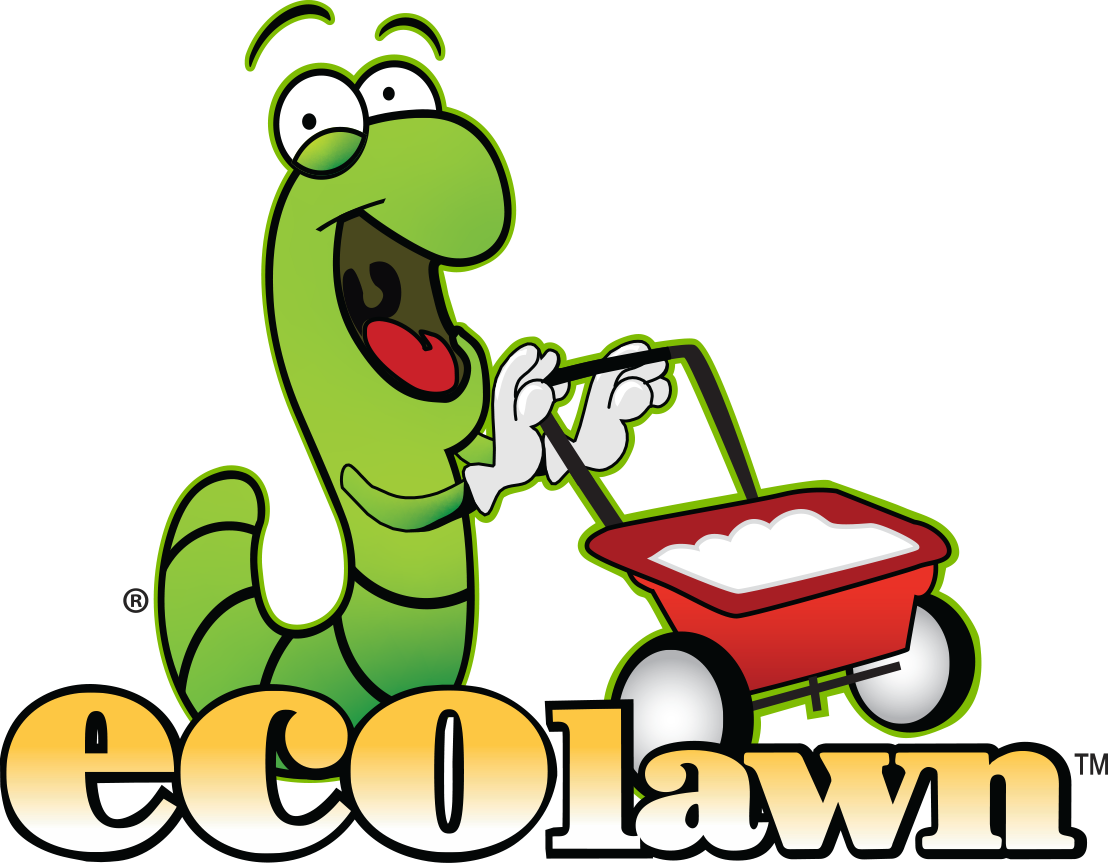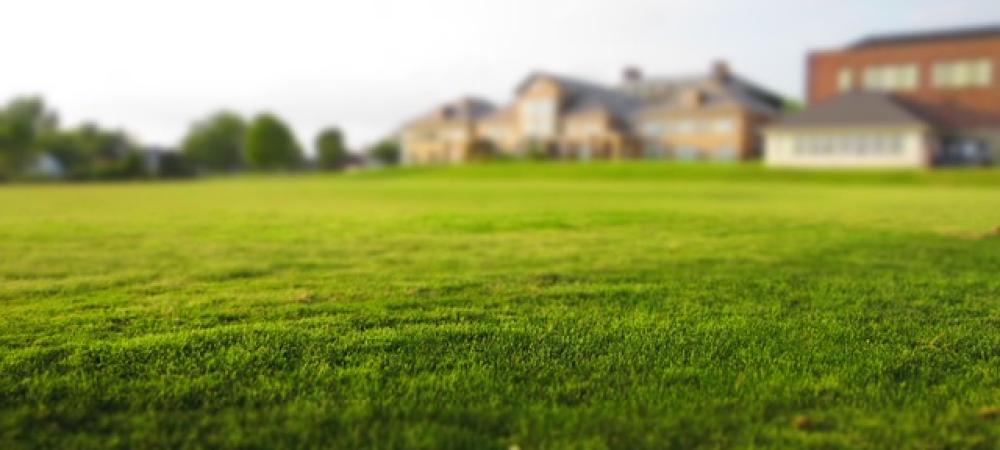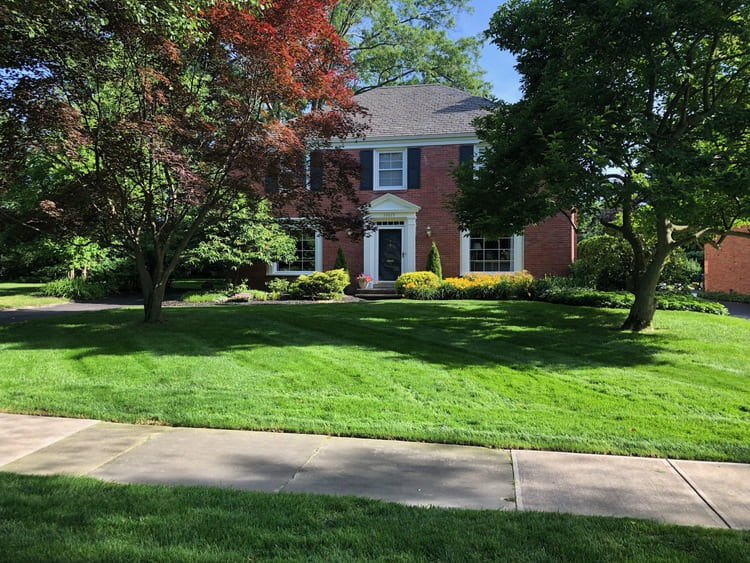Fall in Love with Your Lawn: The Dynamic Duo of Aeration and Overseeding
Fall in Love with Your Lawn: The Dynamic Duo of Aeration and Overseeding
They say the grass is greener on the other side – but in reality, that’s only true if the owner of “the other side” has invested in some good aeration and overseeding.
If your dream is to step onto a lush, vibrant, and healthy lawn every morning, you need to put some thought into how you’re caring for it this fall.
Mechanical aeration, in combination with overseeding, is a key ingredient to creating a lawn that makes your neighbors green with envy – and fall is the best time to do it.
Find out why in this post.
What is Mechanical Aeration?
Mechanical aeration might sound like something out of a sci-fi movie, but it’s a straightforward and highly effective lawn care practice.
Essentially, mechanical aeration involves perforating the soil with small holes to allow air, water, and nutrients to penetrate the grass roots. It’s like giving your lawn a much-needed oxygen boost.
It is typically done using a lawn aerator. That removes small plugs of soil). The result is – looser soil that roots can easily grow through, leading to a healthier lawn.
- Improves soil structure by reducing compaction.
- Enhances nutrient uptake by allowing essential nutrients to reach the roots.
- Promotes root growth by creating a more favorable soil environment
When is Mechanical Aeration Necessary?
Mechanical aeration isn’t a one-size-fits-all solution. Its necessity depends on several factors related to your lawn’s condition.
Look for these tell-tale signs:
- Water puddles on the surface after it’s rained
- Hard, compacted soil that feels like concrete
- Thin, patchy grass that’s struggling to grow
Fall is the ideal time. Cooler temperatures and increased moisture create the optimal conditions for your grass’s recovery and growth.
Check with your technician to learn if mechanical or Liquid Organic Aeration would be better for your lawn.
What is Overseeding?
Overseeding involves spreading grass seed over an existing lawn to fill in bare spots, improve density, and enhance the lawn’s overall appearance.
Typically done after aeration, the process involves:
- Choosing the right seed based on your climate and lawn type
- Evenly spreading the seed using a broadcast spreader
- Watering consistently to keep the soil moist
Like aeration, overseeding offers several benefits. It can:
- Improve the grass density by filling in thin or bare spots
- Enhance lawn health by introducing new, resilient grass varieties
- Reduce weeds by crowding them out with thick, healthy grass when combined with your Ecolawn care program.
When Do You Need to Overseed?
Not all lawns need overseeding every year, but there are certain conditions that might make it a necessary step in your lawn care routine.
To figure it out, take a good look at your lawn. You might want to consider overseeding if you notice bare patches where grass isn’t growing or thinning grass that looks sparse. Overseeding, like aeration, is best done in the fall cooler temperatures and increased rainfall create the ideal conditions for seed germination and establishment.
Why Should You Combine Mechanical Aeration with Overseeding
If you’ve ever peeped over the fence at your neighbor’s lush, green lawn and wondered what their secret is, it might be the dynamic duo of mechanical aeration and overseeding. This powerful combination can transform even the patchiest lawn into a carpet of greenery that’s the envy of the neighborhood.
Here’s how it helps:
Increases the Health of Your Lawn
When it comes to lawn care, mechanical aeration and overseeding are like peanut butter and jelly—they just go better together. But why? First, aeration involves perforating the soil with small holes to allow air, water, and nutrients to penetrate the grassroots.
This not only alleviates soil compaction but also improves the overall health of your lawn. When you add overseeding to the mix, you’re essentially planting new seeds to fill in the gaps, making your lawn thicker and more robust.
Prepares the Lawn for Winter
Winter is coming, and no, we’re not talking about Game of Thrones. Aeration and overseeding prepare your lawn for the cold months ahead.
Overseeding, on the other hand, introduces new, hardy grass varieties that can withstand winter stress better than older, tired grass.
Helps Seeds Germinate Better
Have you ever planted seeds and wondered why only half of them sprouted? The secret to better germination lies in the soil.
Aerated soil provides an ideal environment for seeds to germinate. The holes created during aeration act like little incubators, offering seeds the perfect conditions to grow. When you overseed right after aeration, you give those seeds the best possible start.
Improves Resilience Against Pests
Pests are the nemesis of any beautiful lawn. Mechanical aeration and overseeding can help your lawn fend off these tiny invaders. A well-aerated lawn promotes stronger root growth, making your grass more resilient.
Overseeding with pest-resistant grass varieties can further protect your lawn from damage. Think of it as giving your lawn a flu shot – it’s better prepared to fight off any pests that come its way.
Prevents Disease
Disease is another common lawn issue that can be mitigated through aeration and overseeding. Compact soil traps moisture, creating a breeding ground for fungi and other pathogens.
Aeration improves drainage, reducing the chances of disease. New grass varieties introduced through overseeding may also be more resistant to common lawn diseases, giving your yard an added layer of protection.
Reduces Weed Growth
Weeds compete with grass for nutrients, water, and sunlight, often winning the battle in compacted soil. Aeration breaks up this compacted soil, making it harder for weeds to establish themselves.
Combined with overseeding, which fills in bare spots with robust and healthy grass, this process reduces the space and resources available for weeds to grow.
Makes Your Lawn Look Better
Last but certainly not least, a lawn that has been aerated and overseeded simply looks better. The new grass fills in any bald spots, making your lawn look fuller and more vibrant. The improved health and resilience of your lawn will be evident in its lush, green appearance.
Plus, who doesn’t want to hear their neighbors say, “Your lawn is so much better than mine!”?
Why Fall is the Best Time for Aeration and Overseeding
Technically, aeration and overseeding can be done at any time – but fall is really the prime time.
This is because fall offers the perfect conditions for aeration and overseeding. The cooler temperatures and increased rainfall provide an ideal environment for seed germination and root growth.
Unlike the scorching summer sun, fall weather is gentle on new seedlings, giving them a better chance to establish themselves.
Not only that, but weeds are less aggressive in the fall compared to spring and summer. This means your new grass seeds have less competition for nutrients, water, and sunlight. With fewer weeds to contend with, your grass can grow stronger and healthier, making it easier to maintain a weed-free lawn in the future.
Finally, by aerating and overseeding in the fall, you give your lawn a head start for the following spring. The new grass will have several months to establish strong roots before the growing season begins. Come spring, you’ll be greeted with a lush, vibrant lawn that’s ready to show off.
What the Process Looks Like
At EcoLawn, we used to rely solely on liquid organic aeration – but we realized that some lawns were looking pretty rough due to this season’s weather. We decided to offer mechanical aeration with overseeding to our clients – with amazing results. Here’s what our process looks like:
Step 1: Prep Work
Before we do anything else, we’ll also do any necessary prep work. Because aeration involves digging into the ground, we’ll arrange for any underground utilities to be marked by OUPS. This will keep everyone safe during the aeration process.
We’ll also have you mark any dog fencing or sprinkler heads (or any other lawn features we don’t know about) to avoid damage during aeration. Proper preparation minimizes risks and maximizes efficiency.
Step 2: Mowing and Watering Instructions
Instructions are provided so you see the most germination and greatest success.
Moist soil makes the aeration process easier and provides better seed germination conditions.
overseed can settle deeply into the aeration holes, resulting in a lush and healthy lawn.
Step 3: Mechanical Aeration
Now, this is where the magic happens. Our professional team uses a single-pass hydraulic machine to create small holes by pulling plugs of soil from your lawn.
This process allows air, water, and essential nutrients to reach the roots.
We make sure to cover your entire yard, paying extra attention to heavily trafficked areas. Mechanical aeration breaks up compacted soil, promotes root growth, and reduces thatch buildup, all contributing to a healthier lawn.
Step 4: Overseeding
After aeration, it’s time to overseed. We choose high-quality grass seed suitable for your climate and soil type. At Ecolawn, we prefer Turf Type Tall Fescue due to its high heat and drought tolerance. We spread the seed evenly across your lawn, making sure it falls into the aeration holes for the best chance to germinate and grow.
By carefully selecting the right seed, we ensure that your lawn is resilient and visually appealing. Overseeding fills in bare spots and enhances the overall density of your grass.
Step 5: Fertilizing
Once the overseeding is complete, we apply a slow-release fertilizer to provide your new grass with essential nutrients. A fertilizer high in phosphorus is ideal as it promotes root growth. We follow the manufacturer’s instructions to ensure the correct application rate.
Fertilizing after overseeding gives your new grass the boost it needs to establish strong roots and thrive. We take care to use eco-friendly fertilizers that support healthy growth without harming the environment.
Step 6: Watering and Maintenance
Finally, we water your lawn thoroughly after fertilizing. For the first few weeks, we recommend keeping the soil consistently moist but not waterlogged to ensure successful seed germination.
Once the new grass begins to grow, we will gradually reduce the watering frequency and continue to mow your lawn regularly, avoiding cutting the new grass too short.
Get Your Dream Lawn This Fall
Ecolawn offers comprehensive lawn care services, including liquid organic aeration, tree and shrub care, perimeter pest control, and flea and tick control. Serving Northeast Ohio, including Cuyahoga County, Geauga County, and Lake County, we’re dedicated to helping you achieve the lawn of your dreams.
Combining mechanical aeration with overseeding or LOA in the fall is a key ingredient for a lush, healthy lawn that’s the envy of the neighborhood. This process improves soil health, enhances seed germination, and boosts pest and disease resistance. The fall season provides the perfect conditions for these practices, ensuring your grass starts strong before winter sets in.
So when’s the best time to do this? For the best results, we recommend that you complete your aeration and overseeding by October 15th, but if you’re crunched for time, don’t panic—better late than never!
Ready to transform your lawn? Fill out our consultation form, and one of our expert lawn technicians will be in touch to give your lawn the care it needs to thrive.
Join Our Newsletter
FOLLOW US FOR MORE LAWN CARE TIPS


